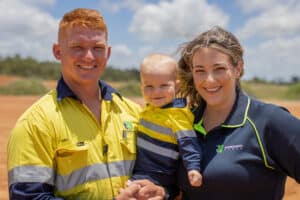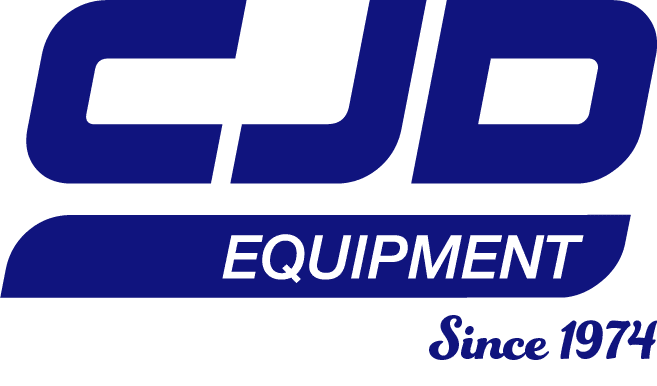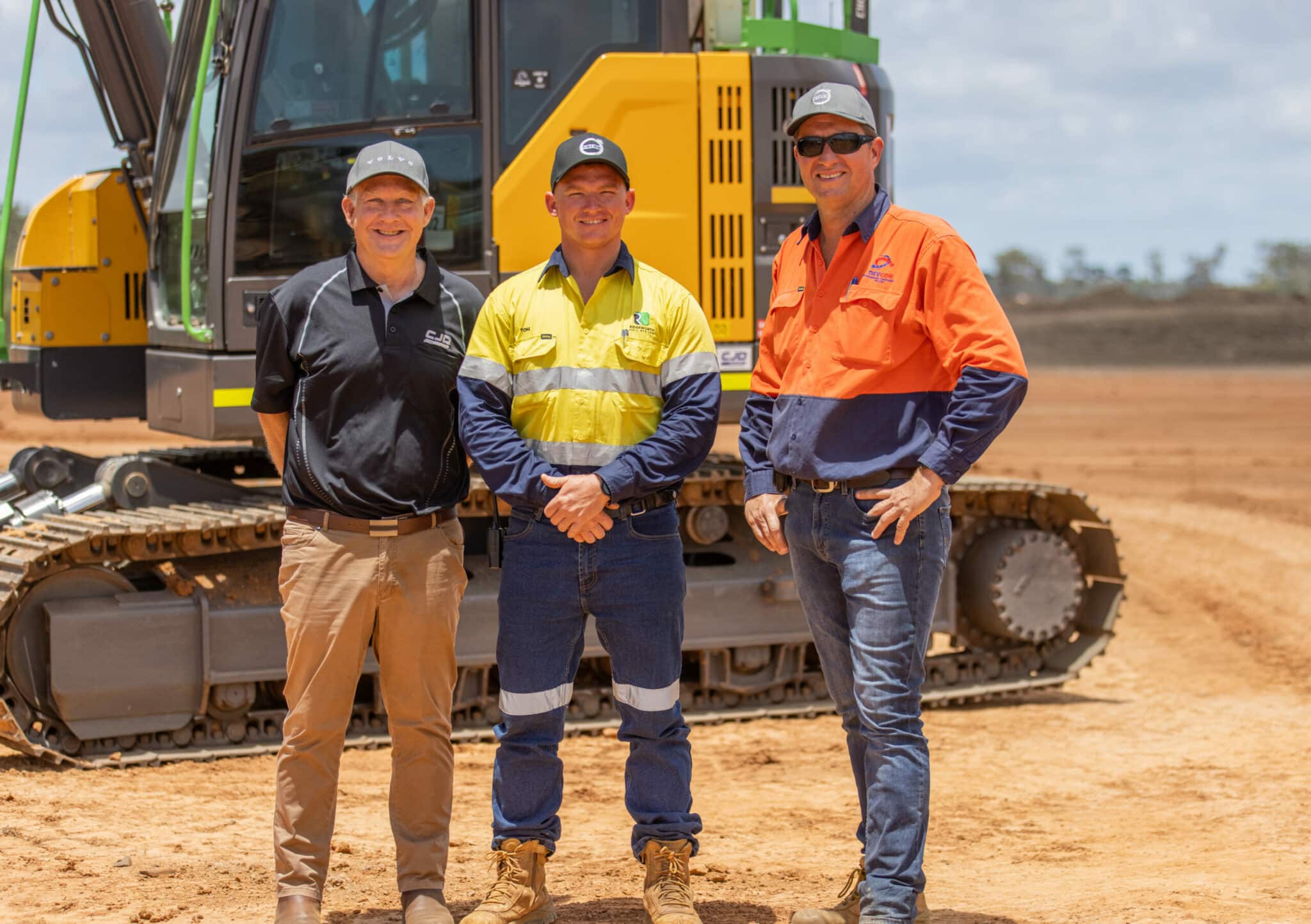Even as a small boy growing up in Bundaberg, Queensland, Tom Langridge, Director of Ridgeworth Civil, knew exactly where destiny was leading him. “For as long as I can remember, I’ve always dreamt of owning my own earthmoving company.
It all started when I was four years old and Mum had a guy with a bobcat come into the backyard to build a shed pad. And from then on, I was obsessed and all I talked about was operating machinery.” he laughs.
Like all good stories, Tom’s has included a few twists and turns. “About eight years ago, I was working for a civil electrical company where we installed traffic lights,” he recalls. “That’s when I realised that, rather than just doing earth moving, I could build a civil works company. I could go bigger if I really wanted to.”
After the civil electrical company went into liquidation, Tom started to work his way into the mining industry.
“It was really just for a bit more money,” he says. “Machines aren’t cheap to buy, and I didn’t come from a fortunate background. There was never any money to buy your first car or stuff like that. So, I had to learn how to save.”
With a laser focus on his goal, Tom took small but important steps towards it. “On my days off, I approached a local civil construction company and offered to essentially work for them for free,” he says. “My idea was they’d get free labour and I’d get the experience and knowledge behind me to start my own company. But the owner insisted they had to pay me. So, I’d do 90 hours, seven days on at the mines, then come home and do 50 hours for this other company on my days off.”
After a couple of years of hard slog, Tom got an opportunity to take things in a new direction. “Andrew who I was working for on the side approached me to come and work for him full time,” he recalls. “But I’ve always had my goals and my dreams to work for myself. That would have pushed my plans of starting my company back by five years. He suggested we draw up an agreement where I’d contract with him on a full-time basis, with an option to buy a machine. That’s where I got my start. I was able to gather the finance to purchase a Volvo ECR235EL excavator. Now I contract to Development Construction, which is DEVCON, full-time.”
Teaming up with DEVCON was another pivotal moment in Tom’s journey. “Andrew Santalucia, the owner, is a fantastic bloke. A friend and a mentor,” he shares. “I have the utmost respect for him. He’s given me an opportunity to chase my dream, and I’m very grateful for it.”
As one of the biggest civil construction companies in the Bundaberg region, DEVCON certainly has quite a few bits of gear. “They run four graders and somewhere around 15 excavators, ranging from 2-ton up to 35-ton machines,” Tom says. “They have loaders, dump trucks, side-tippers, floats, water trucks – all kinds of things. Andrew works on developing subdivisions, road construction, and land development of any sort including agriculture. He’s a very knowledgeable man.” However, Andrew tends to run Komatsu, so how was it Tom ended up with a Volvo?
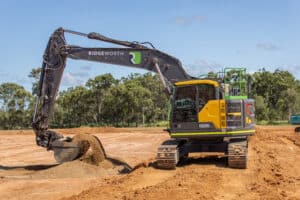
“It’s a bit of a story,” he laughs. “I originally had a Komatsu on order with delivery due atthe end of June. Then Stacey Brown at CJD Equipment called me and said he’d gotten me a quote from Volvo, just to compare it. Because I was going to have finance the GPS equipment for the machine separately, it was starting to get a bit too expensive. Stacey pointed out the GPS hardware comes standard with the Volvo Dig Assist excavators. So it would worked out to be quite a bit cheaper and they could guarantee delivery within a week or two of the start of July. I did feel bad about cancelling on Komatsu and when discussing my plans with Andrew, he said he would happily take over the Komatsu order, so it all worked out well in the end.”
GPS functionality and Dig Assist technology were important inclusions for Tom. “It’s having everything right there on the screen in front of you. You can’t compete with that efficiency.” He explains. “It also saves manpower. You’re able to spread your guys across various sites rather than having extra people just to string lines or use a laser. You don’t need a spotter when you’re digging because you’ve got the screen to tell your height. I think, going into the future, efficiency will come mostly through technology.”
Utilising the Volvo Co-Pilot in-cab interface, Dig Assist technology provides real-time guidance to ensure job parameters are met more accurately. The operator can visualise the excavator bucket and the machine’s position, using GPS, and shows indicator guidelines for trenching on the touchscreen.
Another feature of Co-Pilot is CareTrack, a telematics system, which Tom lists as yet another example of the way technology is changing the earthmoving game.
“It helps you look at a machines performance, measure the idle hours against its run time,” he explains. “Also location…, which is useful for someone running a fleet, like if a machine gets stolen or something. It’s a good bit of technology.”
Another element Tom enjoys is the controls. “The joystick has six rollers on it and multiple buttons,” he says. “So, you can use a button on your joystick to pause your music and talk on your radio without that blaring in the background.”
There’s also an ability to run and switch between multiple programs, which Tom feels is a big point of difference. “You can so easily go between, say, Trimble Earthworks and Dig Assist. Or change a screen to camera at the touch of a button,” he shares. “On another machine, changing over to Topcon would mean revamping all the wiring etc. But because everything’s wired in through the Volvo Co-Pilot, I can have both Topcon and Trimble running on the same machine without moving any sensors. That gives me the flexibility to work on any site.”
Even apart from the technology aspect, there’s plenty Tom rates about the Volvo machines.
“It’s the build quality,” he shares. “Sure, it looks very modern inside – the controls look like something out of a spaceship. But it’s not just inside. It’s all the components. It’s really solid. I don’t think other brands can compete with Volvo, when it comes to value.”
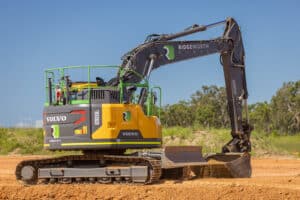
For attachments, Tom’s running Volvo buckets – which he says mirror the build quality of the machine itself – as well as a Batter bucket, a GP bucket, a 600mm bucket and a ripper.
“They’re all used on a tilting quick hitch” Tom says. “It’s big and it’s sturdy. I’d seen this on other machines, so I did a bit of research after CJD Equipment said it comes with it. And I’d heard from Andrew that it is a great feature.”
Tom says the advantage of the tilting quick hitch is the precision he can achieve on certain jobs. “Final trimming is a big one, when you’re cutting in a footpath or cutting the road down to subgrade. Being able to follow your GPS line is fantastic for that” he shares. “And when you’re sanding up your pipes, when you get to the end of your line, rather than have full width of your 1800mm bucket, you can just tilt the bucket and pour it in with the corner. That’s a big win, rather than making a worker shovel the other half of the bucket into the hole. Things like that make it a lot easier. It’s just a very handy tool.”
CJD Equipment has a well-earned reputation for excellent customer service, and Tom’s experience with them only backs that up. “Chris Proctor is the new salesman for this region. And we get on like a house on fire. He’s a good bloke. Anything I need, he’s just always there. I had CJD out the day to do the first 500 hour service on my digger, and the guy spent six hours in the rain doing my service. Which meant I didn’t have any down time, since I was out anyway with the wet weather. That’s a testament as well.”
For maintenance, Tom’s a typical one-man show. “With run of the mill stuff, I handle a lot of that myself,” he says. “But anything outside of what I can do, I can just contact CJD and it’s job done.”
Working with DEVCON keeps Tom pretty busy on major projects around Bundaberg. “We’re currently building an estate with around 30 houses in it,” he explains. “So I did all the sewer, storm water, and the water mains. I’ll be trimming down subgrade, and getting the roads to height before we start throwing the pavement in. All kinds of work that requires the GPS and Dig Assist to make it a bit more efficient.”
This particular job has seen Tom digging some deep sewers. “We had to bench down two meters with two 35-ton diggers and I jumped on their 30-ton machine with the GPS to dig a further five-and-a-half meters down,” he laughs. “It was seven-and-a-half meter trench by the time we finshed – so pretty full on.”
As you’d expect, a guy who’s living his four year old’s dream has a pretty good idea of where he’s headed next. “The first thing is to learn everything there is to know about civil construction,” Tom explains. “So, I will be taking everything I can in from Andrew and his team around subdividing, and civil construction. Especially with GPS and digging styles. I’ve spent a lot of time on machines, but when it comes to civil and trenching – especially at that depth of like seven-and-a-half metres, there’s still a lot more experience to come. Then the next move, of course, will be to buy another machine.”
When it comes to that purchase, Tom has a few options but has his eye on a particular machine.
“I would love a 30 ton Volvo excavator or grader,” he laughs. “Because occasionally, I let other blokes operate my machine while I go jump on either another excavator, grader or a loader. So that would make a lot of sense.”
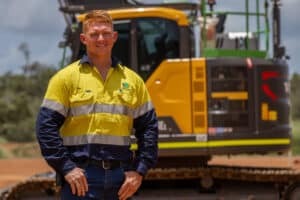
Almost a year into starting his own venture, Tom’s advice to anyone thinking of going down that route is to be intentional and prepare to take the odd leap of faith. “You need to be a little bit smart,” he says. “Make sure you’re in a good position. When my wife, Tegan, and I started the company, we were about to have our first child. Having our first kid at the same time you start a new civil company was a bit daunting. But I’ve always told myself that as long as the health and wellbeing of my family are fine, I can take on anything.”
While for many buying a second-hand machine is their only way in, Tom says there are numerous advantages to building a long-term connection with a reliable dealer. “Look, it’s what you’re comfortable with, but when it comes to maintenance and parts and stuff like that, it is good having them all under the same banner,” he says. “You’ve got to with your gut instinct. I felt comfortable buying a brand-new machine because it’s under warranty, and it gives me a relationship with the dealer. I know I’ll be purchasing more machines down the track, so it’s in my best interest to create that relationship. It works in your favour when it comes to purchasing, servicing, getting parts in on time and stuff like that.”
2023 will see Tom and Tegan celebrate a couple of milestones, with Ridgeworth Civil coming up to its first anniversary and their son, Oliver turning 1 in April. “He is just my whole world,” Tom shares. “And it was just a dream come true to have Ollie come sit in the machine with me when it was delivered. As I said, growing up I used to stop on my walk home from school to watch the machines through a fence. So, to able to give my son that opportunity at such a young age – it’s a massive thing for a kid.”
As Ollie and the business grow together, what’s the 10-20 year plan for Ridgeworth Civil? “By then I’d like to be chasing work nationally. I want to grow something bigger than just Bundaberg, but I know that’s something that happens over time, so I’m keeping it realistic,” Tom laughs.
In the end, it’s his love for his family that fuels his fire. “The thing that keeps me going is I want to create an opportunity for my family where they don’t have to worry,” he shares.
“If they want to go to university or travel around the world, I want to be able to give them that. And I’m fortunate to be doing something I’m passionate about. I don’t have many hobbies outside of work because this is essentially a hobby I’ve chased since I was four years old. So, to be able to do this for a living, I don’t really see it as work. It’s me doing something I love every single day.”
Tom’s earning a reputation around the traps as someone to watch. And if his story proves anything, it’s that with perseverance and determination, he can get anywhere.
